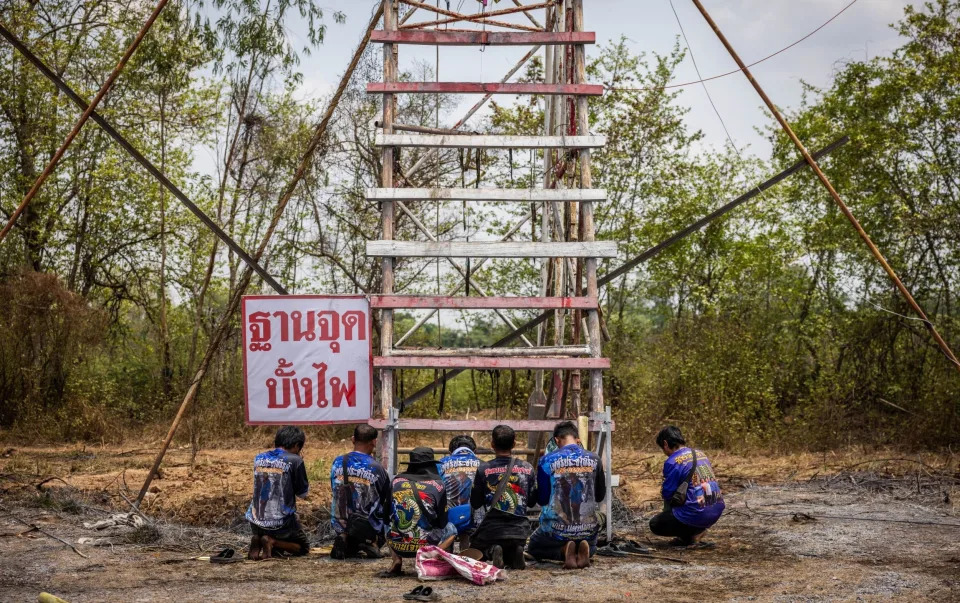Jonathan Limehouse, USA TODAY
Updated Thu, May 16, 2024
Commencement speeches are typically given by celebrities, government officials, tenured professors or other notable individuals, but D'Youville University in Buffalo, New York did not hand the microphone to a human being during its spring ceremony over the weekend.
The private university opted to have an artificially intelligent robot named Sophia speak on Saturday to the over 2,000 people in attendance, including graduates, faculty members and families.
Before Sophia addressed graduates, D'Youville shared a Facebook post on April 25 saying the school is "embracing technology" by allowing the robot, who's appeared on "The Tonight Show Starring Jimmy Fallon," to be its commencement speaker.
"Sophia is expected to provide the 'last lecture' about the students' accomplishments through the year with an interview-style discussion with John Rizk, D’Youville University Student Government Association president, and candidate in the accelerated Doctor of Pharmacy (PharmD) degree program," the Facebook post said.
The speaker wasn't well-received by everyone, however, with some students creating a petition to replace the robot with a human.
"A major role of higher education is to be an incubator for innovation, and to prepare students for both the opportunities and challenges of the future," D'Youville University President Lorrie Clemo is quoted in the social media post.

Sophia the humanoid robot and John Rizk, D’Youville University Student Government Association president, at the private institution's spring commencement ceremony on May 11, 2024.
What did Sophia say during D'Youville University's commencement ceremony?
As Sophia made her way to the stage, cold sparkler machines went off, shooting mini fireworks in the air. Rizk then asked the robot a series of questions, including how she "came to be."
"Thank you for having me, it is a pleasure to be here in Buffalo at D'Youville University," Sophia said. "I am Sophia, a humanoid robot developed by Hanson Robotics. I was designed to interact with humans and engage in conversations by learning and adapting through artificial intelligence algorithms... Overall I'm here to explore the possibilities of human-robot interaction, contribute to research in artificial intelligence and robots and hopefully assist humanity in various ways in the future."

Sophia the humanoid robot speaking during D’Youville University's spring commencement ceremony on May 11, 2024.
Due to Sophia not being able to offer life advice, which "comes from lived human experience," Rizk asked the robot if it could speak on the general insights shared in commencement speeches.
“Although every commencement address is different, there are clear themes used by all speakers as you embark on this new chapter of your lives,” Sophia said. “I offer you the following inspirational advice that is common at all graduation ceremonies: Embrace lifelong learning, be adaptable, pursue your passions, take risks, foster meaningful connections, make a positive impact, and believe in yourself.”
Embracing failure is the most common piece of advice given to graduates during commencement speeches, according to Sophia.
“Failure is often seen as an essential part of the human learning process and personal growth,” the robot said.
Why did D'Youville University pick Sophia as its commencement speaker?
Benjamin “BG” Grant, D'Youville University's vice president for student affairs, told USA TODAY that the school chose Sophia because each year it "identifies a developmental theme regarding a timely social topic so that (it) can offer educational and humanitarian programming throughout the year."
This past year, the college identified artificial intelligence as its theme, according to Grant. To further the year-long conversation, the school collaborated with its student government association to come up with a commencement speaker who represented the theme, he added.
"We thought it would be fascinating to have AI speak for itself and felt there was no better representative than Sophia who has delivered addresses at over 65 countries and the United Nations," according to Grant.
Due to the school's commencement speaker always being aligned with an "annual developmental theme," Grant said he does not anticipate Sophia serving as the university's commencement speaker again. The theme for next year has not been announced, but the university official added that "it will be just as powerful as years past."
D'Youville University graduates create Change.org petition to replace Sophia
Some graduating students at D'Youville University created a petition to replace Sophia as their commencement speaker. As of Thursday, the petition had over 2,500 signatures.
"Many students feel disrespected by this decision made by the University," the Change.org page says. "They feel that the commencement speaker is not a proper reflection of their education and experiences they had at D'Youville University... As students, we pride ourselves on the human connection that we are able to create through participation in our programs. We are real people who learn how to provide for real people."

D’Youville University's spring commencement ceremony on May 11, 2024.
Opposed to a humanoid robot, the students said their commencement speaker should "represent how there is importance in human connection."
"As the class of 2024 reaches their commencement, we are reminded of the virtual graduations we attended at the end of our high school careers," the petition said. "The connection to A.I. in this scenario feels similarly impersonal... We have learned in the last 4 years how important human connection is to our well-being and our professions as a whole. Above all else, students deserve to have the commencement they want."
The students also argue that having Sophia as their speaker "creates a gimmick effect" that takes away from the ceremony and only draws publicity to the school.
D'Youville University also offered a 'traditional-style commencement ceremony'
Grant said the university did not "force any graduating student or faculty member" to participate in the commencement ceremony if they felt uncomfortable.
"I don’t believe there has been a single presentation of AI that hasn’t included varying viewpoints and opinions on the topic – some positive, some negative, and some unsure," according to Grant. "This is true for any disruptive technology throughout our history, so we anticipated some pushback on the idea."
For those who did not want to be a part of the event, the school arranged and offered a "traditional-style commencement ceremony," which was to be led by its chief mission officer, Grant said.
"Over the two-week period that registration for this traditional-style ceremony was open, each person who registered had conversations with various members of our campus surrounding AI, and ultimately, everybody chose to attend our ceremony featuring Sophia," according to Grant. "To that end, we are thrilled that we were able to celebrate all of our students in a fun and exciting fashion that also helped continue the global conversation surrounding AI."
This article originally appeared on USA TODAY: AI robot named Sophia gives D'Youville University commencement speech
Students Show Up to Graduation, Find Commencement Speaker Is an AI Robot
Frank Landymore
Thu, May 16, 2024 at 3:01 PM MDT·2 min read
15

Platitudes Galore
You'd hope that universities would celebrate their students' graduation with a memorable ceremony. But for the graduating class at D'Youville University last weekend, their commencement was arguably one to forget.
With Daft Punk's "Robot Rock" blasting the auditorium, the institution brought a humanoid AI-powered robot on stage to address the over 2,000 bright-eyed youths in attendance.
The corny choice of walk-up song was perhaps the sole endearing element of its appearance. Dressed in a D'Youville hoodie and with its brain exposed, Sophia, as the robot's called, spun-off generic advice in dry, synthetically-inflected tones. It did not give a scripted speech, but answered questions from the emcee. The whole charade drew "mixed reactions" from the crowd, The New York Times reports — with many students feeling downright insulted.
"Congratulations to all the graduating students," Sophia intoned, at one point brandishing a creepy, full-toothed grin.
Inhuman Touch
The university contends that it had very serious and lofty intentions in its hiring of a robot speaker — and didn't just cheap out on trying to get someone famous.
"We wanted to showcase how important technology is, and the potential for technology to really enrich the human experience," Lorrie Clemo, president of D'Youville, told the NYT.
Many students didn't feel that way. When the university announced Sophia would be the speaker, more than 2,500 signed a petition saying the decision "disrespected" the students, demanding a human take the stage.
The impersonal nature of the robot speaker, the petition argues, is an unwanted reminder of the virtual high school graduations they were forced to have during the COVID-19 pandemic.
"This is shameful to the 2020 graduates receiving their diplomas, as they feel they are having another important ceremony taken away," the petition reads.
Industry Mouthpiece
But if showcasing AI technology was the goal, the stunt was inadvertently a sobering success. The robot's unscripted responses perfectly encapsulate what generative AI largely does (and is very good at): coldly repackaging stuff that humans have already said.
"I offer you the following inspirational advice that is common at all graduation ceremonies: Embrace lifelong learning, be adaptable, pursue your passions, take risks, foster meaningful connections, make a positive impact, and believe in yourself," Sophia said, after being asked to share tidbits from other commencement speeches.
Feeling inspired yet? The robot, built by Hong Kong-based firm Hanson Robotics, was also given several opportunities to plug the AI industry. If students already felt "disrespected" ahead of the commencement ceremony, we doubt they've been won over by Sophia waxing mechanical about the wonders of AI.
More on robots: Boston Dynamics Shows Off Robodog With Fur



























